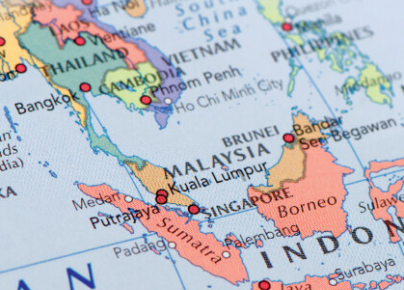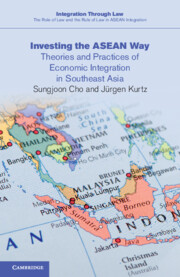
ASEAN in the Limelight
The contemporary global vortex of geopolitics and geoeconomy throws one region into sharp relief: ASEAN. Despite a double tribulation of the United States – China trade war and the outbreak of the COVID-19 pandemic, the economies of the ASEAN member states have demonstrated remarkable levels of resiliency. While Asia’s trade volume had contracted by ten percent on a year-on-year basis by May 2020, “high frequency indicators” such as global shipping, packaging indexes and port calls, herald Asia’s faster-than-expected economic rebound (ADB 2021). In fact, Southeast Asia remains the most integrated area in Asia (driven by trade and investment) as measured by the Asia-Pacific Regional Cooperation and Integration Index (ARCII) (ADB 2021).
Moreover, the newly-minted Regional Comprehensive Economic Partnership (RCEP) is hailed as a golden opportunity for ASEAN members to deepen trade and investment liberalization among themselves to maximize the RCEP’s true potential being the synthesis of extra-ASEAN and intra-ASEAN economic flows. The potential benefits of using foreign investment to position ASEAN as an integrated production base are extraordinary, including the possibility of higher employment, wages and overall development throughout the region. Given that approximately 25 per cent of total FDI flows into the ASEAN region originates from non-ASEAN RCEP member countries, ASEAN economies are expected to benefit greatly from the RCEP connectivity through a deep nexus between trade and investment. Consider the telling point that the top 100 multinational enterprises (MNEs) from non-ASEAN RCEP member countries retain commercial presence in the ASEAN region, holding an enormous investment potency of $13.6 trillion in assets and $1.1 trillion in cash as of 2019 (ASEAN Investment Report, 2021).
This auspicious background lends credence to the main thesis of our recent book (“Investing the ASEAN Way: Theories and Practices of Economic Integration in Southeast Asia”) published by Cambridge University Press. In this book, we argue that ASEAN’s characteristics are uniquely situated to incentivize foreign investment into the region. In comparison to its equivalents in Europe or North America, the ASEAN Investment Regime (AIR) is distinct in the sense that it has been evolved against the background of open regionalism as well as a robust working relationship between the government and the business sector. Thus, any future legal and institutional upgrading of the AIR must be able to harness these rich traditions to contribute effectively to the common prosperity of the region. In particular, the clichéd Western-style of formal legalism must be rethought and reinvented in a way which complement, not supplant, the deep-rooted cultural fore-structures within the region.
A New Theoretical Optic
Conventional international relations (IR) theories, such as neorealism, rational choice theory and neoliberal institutionalism, mostly adopt a micro framework. They are collectively coined “rationalism” in that they presuppose isotropic, rational actors (states) whose actions are guided by a common thesis of substantive rationality represented by efficiency, power and interest (Keohane, 1988). These conventional IR theories would theorize AIR as a welfare-maximizing contract in which states’ interests and preferences determine various institutional choices. While these conventional IR theories offer useful heuristics in understanding the origin of AIR, they cannot fully capture the complex “changes” that AIR makes over time. One of the structural qualities of the AIR is its evolution over time across multiple iterations (1987, 1998 and 2009). Yet the paradigms provided by conventional IR theories are necessarily functional and therefore inherently static. Their characteristic methodological individualism adopts states (agency) as a primary analytical unit (Wendt, 2004). Under this view, AIR is merely an instrument that serves various utilitarian functions that rational states would desire, such as providing information, reducing uncertainties, and monitoring cheating (Barnett & Finnemore, 1999). In sum, conventional IR theories may offer various functional snapshots of AIR, but not its panoramic identity qua organization.
Therefore, we need a new theoretical framework through which we can conceptually embrace the ontological autonomy of AIR so as to investigate its dynamic institutional development. AIR’s institutional decision, or collective consciousness, cannot be the result of a mere aggregation of the interests of its individual member states. Our preferred theoretical underpinning of AIR’s organizational autonomy is one of constructivism. A sociology-led approach, especially constructivism, distinguishes itself from conventional IR theories as it highlights a social structure, rather than agency, that constructs the culture and identities of those actors. Here, one critical aspect of AIR’s institutional development is that as an autonomous organization, AIR incessantly interacts with its surrounding environment for its growth and survival. That external environment is both a resource and a threat to an organic entity like AIR. Harnessing and adapting to its environment is essential to AIR’s survival (Scott, 1992).
Main Thesis in Summary
Using these methodological tools, this book explores regional economic law and governance in ASEAN through a lens of its regulation of foreign investment. ASEAN economic law and governance features a complex yet distinct set of traits, which can be epitomized as a dynamic legal interaction of centripetal force (represented by global economic norms) and its centrifugal counterpart (defined by ASEAN’s unique historical and cultural traits). Rather than defending a narrowly articulated thesis, our goal in this book is three-fold in a broad sense.
First, we aim to interpret legal and institutional fore-structures of AIR through the lens of the ASEAN Way. The political, diplomatic and cultural traits that comprise the ASEAN Way have been constructed from the region’s unique historical legacies, including colonialization, external interventions during the Cold War and the Konfrontasi. The ASEAN Way can be symbolized by its emphasis on the principle of non-interference and consensus decision-making engineered by informal working-level deliberations prior to high-level summitries (Boyce, 1973). Under the ASEAN Way, legalization may be “neither inevitable nor desirable” (Kahler, 2001). The creation of “Senior Officials Meeting” (SOM) in various sectors, such as economics, the environment, and science, as well as national secretariats in the foreign ministry of each member has prioritized trans-governmental cooperation in the ASEAN over more legalistic/judicial strategies (that is so prominent in other regional settings such as the EU).
Second, we seek to identify apposite theoretical paradigms that capture the unique realities of the AIR. While recent controversies in international economic law are mostly directed at Western phenomena such as those related to Brexit and the new trade politics of the United States, the legal academy has been slow to recognise the richness and distinctiveness inherent in the legal facets of ASEAN. To be sure, there are a number of valuable explorations of the ASEAN investment system from a doctrinal legal perspective. In this book however, we focus on the many non-legal forms of cooperation and characteristic flexibilities in ASEAN’s economic regulation which we argue provide both scholars and policymakers with new insights on the conceptualization of law and legalization in global economic governance.
Third, informed by these rich theoretical frameworks, this book seeks to chart not only the past and present but the future of the AIR. It elucidates the historical evolution of AIR as it explores the incorporation of external norms (Global Investment Law: GIL) and the adaptation of those norms in light of the specific needs and deliberative modalities of the ASEAN states. AIR subscribes, superficially at least, to the Western legalization paradigm in the form of GIL, which might be a (regrettable) tendency as a (soft or hard) benchmark. Yet, ASEAN states have transcended this external start-point to endogenously (and strategically) position ASEAN as an integrated production base. Properly implemented, this normative goal promises much. For the many developing countries within the ASEAN grouping, the unbundling of production facilities embedded in global value chains (GVC) can be a significant opportunity. Participation in a GVC holds out enormous promise of development spill overs at a lower entry cost than past strategies, particularly those focused on jurisdictionally bounded industrialization (Baldwin, 2016).
That said, there is cause for caution in some of the puzzling implementation modalities employed within the AIR, not least the paradox of “reverse open regionalism” and its attendant disadvantages. Reverse open regionalism refers to a situation in which a better treatment is accorded exclusively to external (non-ASEAN) members to the detriments to insiders (ASEAN members), thus open to outsiders yet closed to insiders. The persistence of the intra-ASEAN and extra-ASEAN investment gap prevents ASEAN members from maximizing the development potential of investment liberalization, as is often seen in the “hub-and-spoke” model. This paradox, if left unaddressed, will deter ASEAN economies from achieving the “ASEAN Centrality” goal as intra-ASEAN investment flows and extra-ASEAN investment flows remain separated and uncoordinated. The challenge of redressing the paradox of reverse open regionalism is imperative to entrenching ASEAN’s evolution from a mere “Factory ASEAN” to a more mature form of market integration. Closing the gap between intra-ASEAN and extra-ASEAN investment liberalization will engender a dialectic relationship between these two dimensions of liberalization as envisioned in the launching of the ASEAN Economic Community. Considering ASEAN’s unique socio-cultural characteristics, adequate mobilization of human agency through ASEAN government networks, rather than relying on a formal treaty-making process, is key to fulfilling this strategic vision.

Latest Comments
Have your say!